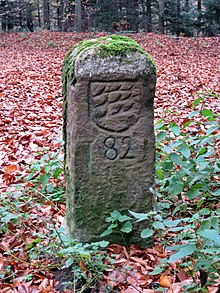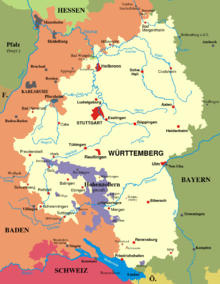Border treaty between Württemberg and Baden
The border treaty between the Kingdom of Württemberg and the Grand Duchy of Baden of October 2, 1810 belongs to a cascade of treaties that were concluded between the states of Bavaria , Württemberg, Baden and Hesse in Paris in 1810. The border between Württemberg and Baden created in this treaty existed in Baden-Württemberg until the major administrative reform in 1973 and has also been largely preserved to this day, for example in the areas of responsibility of the Protestant regional churches and the Catholic dioceses.
Political requirements
The preamble to the treaty, which was concluded in Paris , not by chance , outlines somewhat vaguely “the intention to relate those stipulations in the treaties mutually concluded with France at Compiegne on April 24th and Paris on September 7th of this year Both courts have been met. ”The border treaty concluded between Bavaria and Württemberg on May 18, 1810 describes the political starting point more clearly . Both "previously unadjusted marginal differences and other mutual claims" had to be ended all at once and in a permanent manner, and "those stipulations which had been stipulated in the treaties recently concluded by both parties with France had to be fulfilled by a final contract" become. Herewith the pressure of the Emperor of the French, Napoleon Bonaparte , on the South German Princes of the Rhine Confederation is described without further ado . Napoleon wanted to create three efficient states in southern Germany - Bavaria, Württemberg and Baden - that would be able to meet his demands for troop provision. According to the provisions of the Peace of Pressburg of December 26, 1805 and the Treaty of Schönbrunn of October 14, 1809, the Kingdom of Bavaria was given too generous consideration. As compensation for the profit made by Tyrol and Salzburg, Bavaria was to cede areas in the west to Württemberg, which would then compensate Baden in the further course. Each of the three states should have access to Lake Constance. Finally, Baden was supposed to compensate the Grand Duchy of Hesse . While the treaty between Bavaria and Württemberg does not specify a specific number of inhabitants, Article I of the treaty between Württemberg and Baden stipulates a volume of “45,000 souls” for the exchange of territory.
Contracting parties
King Friedrich I of Württemberg appointed his ambassador extraordinary, Heinrich Levin von Wintzigerode , and Grand Duke Karl Friedrich von Baden appointed his interior minister, Baron Conrad Karl Friedrich von Andlau-Birseck, as plenipotentiary. The treaty stipulates the course of the border "in order to comply with the specific request of His Majesty the Emperor" (Napoleon), and specifies in detail the assignment of territory from Württemberg to Baden.
The logically preceding border treaty between Bavaria and Württemberg was also concluded in Paris on May 18, 1810.
Borderline
The most important assignment concerned the former Upper Austrian Landgraviate of Nellenburg and its accessories , which fell to Württemberg in 1805 . The area, also known as Hegau , played a key role: for Württemberg it secured the connection to Switzerland , which is important for trade , and for Baden it enabled access to the properties on Lake Constance acquired from 1803 to 1805. This becomes clear in Article XIII of the treaty when the "Baden grand ducal court under the above-mentioned imperial French guarantee" undertook not to increase any tariffs on the routes from Tuttlingen via Engen , Thayngen to Schaffhausen and from Riedlingen , Mengen via Meßkirch , Stockach and Radolfzell and not to "raise commercial obstacles."
Furthermore, old Württemberg areas such as the Hornberg office with Sankt Georgen in the Black Forest , Schiltach , Hornberg , Gutach and Reichenbach as well as other areas of Baden were added. The endeavor to dissolve existing condominiums through the assignment of territory is clearly recognizable.
Württemberg ceded to Baden:
- Oberamt Stockach (to the Baden district offices of Stockach , Konstanz and Engen , Linz to the district office of Heiligenberg , Sipplingen to the district office of Überlingen ):
- Landgraviate of Nellenburg
- with the city of Stockach (the official seat of the Landgraviate of Nellenburg), the city of Radolfzell (the administrative city for Nellenburg), the city of Aach ,
- with the camera locations Heudorf im Hegau , Hindelwangen , Liptingen , Schwandorf (regional court in Hegau and Madach ), Mahlspüren im Hegau , Nenzingen , Raithaslach , Sipplingen , Winterspüren , Zoznegg ,
- Jurisdiction Schlatt am Randen ( Principality of Fürstenberg ),
- Rulership of Rickelshausen (from Senger and Etterlin ),
- Standesherrschaft singing and Mägdeberg ( Enzenberg )
- Jurisdiction Büsingen ( Junker im Thurn ),
- Zizenhausen civil status (power from Festenberg to Frohnberg),
- Jurisdiction Hof Neuhaus near Radolfzell ( Physicus Dr. Allmayer),
- Obervogteiamt Münchhöf ( Salmannsweiler Abbey under Nellenburg sovereignty),
- Dominion Obergailingen ( St. Katharinental Monastery under Nellenburg sovereignty),
- Lordship of Hoppetenzell ( Order of St. John , Coming Überlingen ),
- Spitalisches Amt Sernatingen in Nellenburg (imperial city Überlingen) (1826 renaming of Sernatingen to Ludwigshafen ),
- Rule Reute im Hegau (Schaffhausen under nelle burgi shear sovereignty)
-
Imperial Knighthood , Swabian Knight Circle , Canton in Hegau, Allgäu and Lake Constance (the canton was divided into the Allgäu-Bodensee districts with offices in Wangen and Hegau with offices in Radolfzell):
- Lordship of Hohenstoffeln (Baron von Hornstein ),
- Pfaffwiesen in the Hohenstoffeln domain ( Truchsess von Waldburg-Zeil-Zeil and Trauchburg ),
- Rule Hohenkrähen (Baron von Reischach ),
- Dominion Heilsberg and Randegg (Baron von Deuring ),
- Herrschaft Gailingen (Baron von Liebenfels, condominium with the city of Schaffhausen),
- Reign of Bodman ( Bodman to Bodman ),
- Reign of Schlatt among crows (Bodman to Bodman),
- Lordship of Kargegg ( Bodman zu Kargegg ),
- Lordship of Langenstein (Baron von Welsperg ),
- Lordship of Beuren an der Aach (Baron von Liebenfels, later to Baron von Welsperg),
- Dominion Steißlingen (Baron von Stotzingen ),
- Lordship of Mühlingen (Baron von Buol ),
- Lordship of Berenberg ( Count of Beroldingen ),
- Lordship of Linz (Archduke of Austria ),
- Reign of Mainwangen (Salmannsweiler Abbey),
- Reign of Homburg ( Hochstift Konstanz ).
- From the Oberamt Tuttlingen (to the Baden District Office Donaueschingen , Gutenstein to the Baden District Office Stetten am kalten Markt ):
- Parish of Öfingen ,
- Landgraviate of Nellenburg
- Biesingen
- Gutenstein rulership (Count Schenk von Castell ).
- From the Oberamt Ebingen (to the Baden district offices of Meßkirch and Stetten am kalten Markt ):
- Upper Imperial County Hohenberg ( Upper Austria ),
- Kallenberg Castle without the associated villages ( Freiherr von Ulm zu Erbach ),
- Herrschaft Werenwag (Baron von Ulm zu Erbach),
- Obervogteiamt Stetten am kalten Markt (Salmannsweiler Abbey under Hohenberg sovereignty),
- Lordship of Hausen im Tal (Salmannsweiler Abbey in the Imperial Knighthood, in the Swabian Knight Circle and in the canton in Hegau, Allgäu and Lake Constance).
-
Upper Office Hornberg (to the Baden District Office Hornberg ):
- the old Württemberg Oberamt Hornberg with Hornberg , Schiltach , Buchenberg , Gutach , Kirnbach , Königsfeld in the Black Forest , feudal court , Mönchweiler , Peterzell , Reichenbach , hamlet ,
- Parts of the old Württemberg monastery office St. Georgen with St. Georgen , Brigach , Langenschiltach , Oberkirnach , Stockburg , Ev. Tennenborn .
- From the Oberamt Rottweil (to the Baden District Office Villingen ):
- Parts of the old Württemberg monastery office of St. Georgen with Kappel , Schabenhausen ,
- Property of the imperial city of Rottweil :
- Brotherhood Head Nursing Office ( Dauchingen , Weilersbach ),
- Pürschvogteiamt ( Fischbach , Sinkingen ),
- Imperial Knighthood, Swabian Knight Circle, Canton on the Neckar and Black Forest ( Niedereschach ).
- From the Maulbronn District Office (to the Pforzheim District Office in Baden , Ruit to the Bretten District Office ):
- Parts of the Maulbronn Monastery Authority ( Ruit , Öschelbronn ),
- Kieselbronn condominium in the imperial knighthood, Swabian knight circle, canton Kraichgau ( Göler von Ravensburg ).
- From the Oberamt Brackenheim (to the Baden District Office Bretten ):
- Vogtei Kürnbach (Condominium Duchy of Württemberg with Landgraviate Hessen-Darmstadt , Kürnbach Württemberg's share of Baden).
- From the Mergentheim District Office (to the Gerlachsheim District Office in Baden ):
- Amt Balbach (Condominium Duchy of Württemberg with high and German mastery of the Teutonic Knight Order, Tauberoberamt Mergentheim , Oberbalbach Württemberg's share in Baden),
- The village of
Web links
- "Master agreement between the Kingdom of Würtemberg and the Grand Duchy of Baden of October 2, 1810" on the website documentArchiv.de


